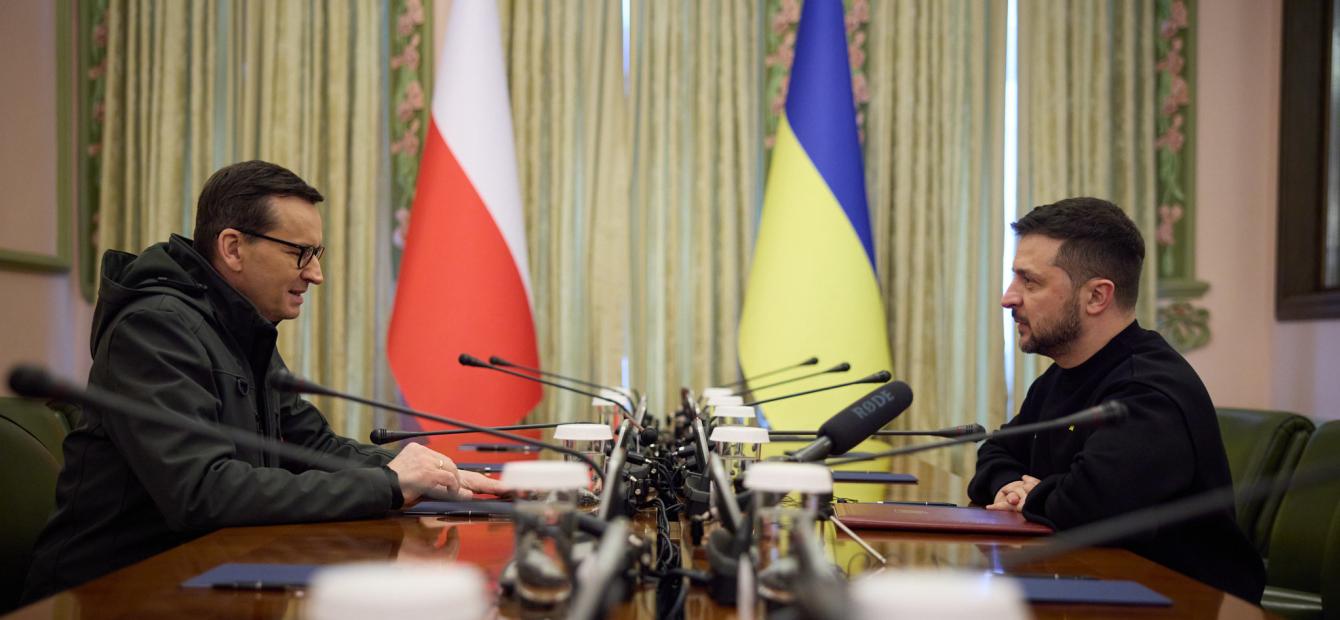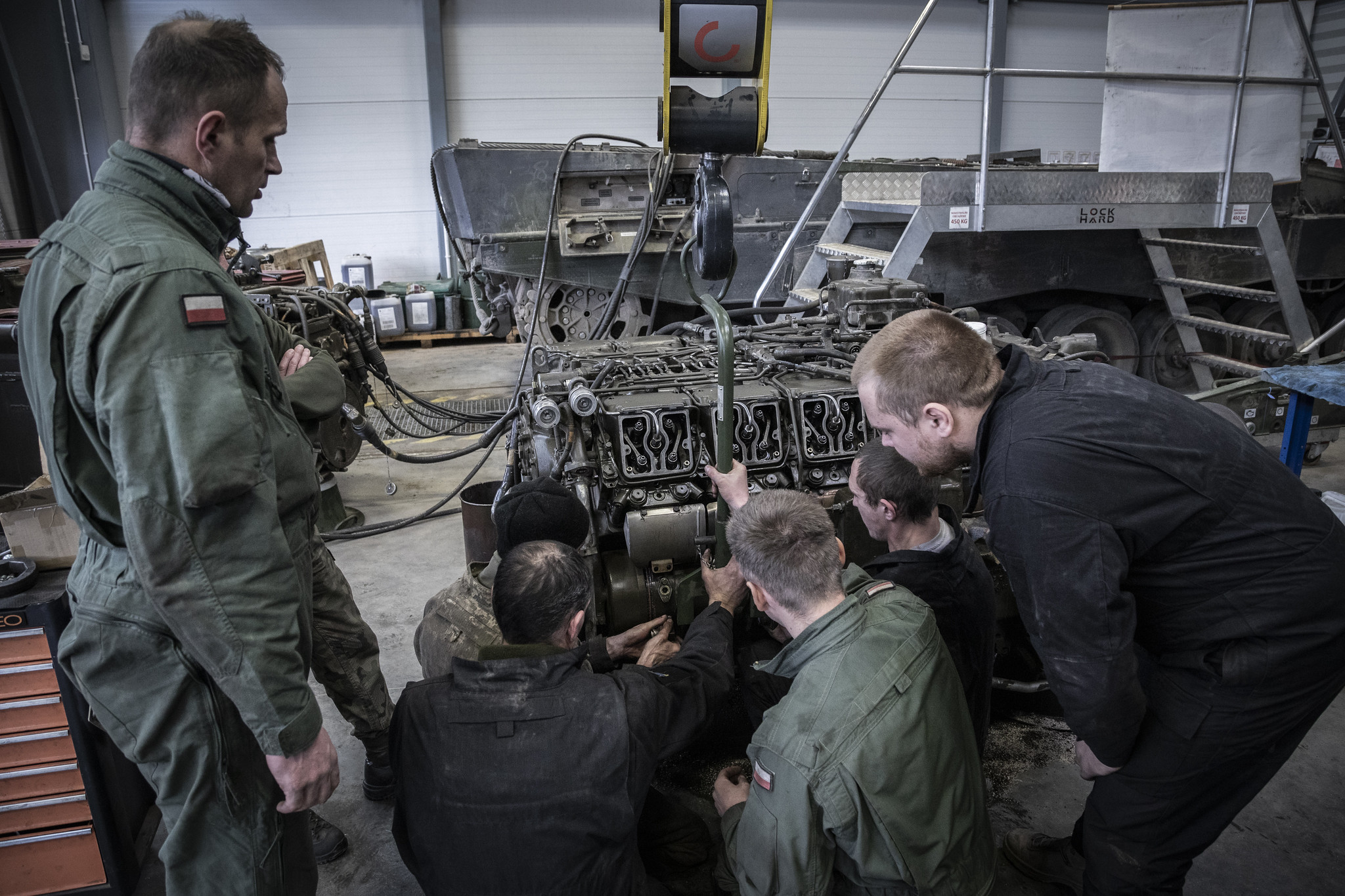
Coping with cracks in the strategic Polish-Ukrainian bond
Poland has been one of Ukraine’s most loyal allies in repelling Russia’s aggression since February 2022. However, recent challenges, including disputes over Ukrainian grain exports, uncertainties in defence collaboration and disagreements on historical matters, have put this strong partnership under pressure. With the electoral dust settling down, it is time to examine the unresolved issues within the Polish-Ukrainian relationship and what future ties might look like.
Since February 2022, Poland has stood as a steadfast supporter in Ukraine’s war efforts to counter Russia’s aggression. Still, even a strong partnership like theirs can come under pressure. Quarrels over the export of Ukrainian grain, Poland’s wavering defence collaboration with Kyiv, and disagreements over shared historical events have emerged in recent months.
Although the Polish-Ukrainian bond – which is largely based on common security threats – will likely endure, it is important to map out the cracks in the relationship and comprehend the stance that a new Polish government may take vis-à-vis Ukraine. With the prolonging war in Ukraine, both countries need to carefully weigh disparities of interests against their shared strategic goal: the containment of Russia.
The subsequent drop in grain prices caused a major economic and political outcry
Given the symbiotic relations in the first months of the war, the intensity of recent disagreements between Warsaw and Kyiv may come as a surprise. Scrapping the bilateral meeting between Ukrainian president Volodymyr Zelensky and his Polish counterpart Andrzej Duda at the UN General Assembly in New York in September 2023 was accompanied by increasingly antagonising rhetoric from both sides, only gaining intensity in the recent months.1
This article analyses the unresolved bilateral issues within the strategic partnership between Poland and Ukraine, and what future ties may look like.
Tensions over grain
One significant factor to this decline was the issue of Ukrainian grain exports. Prior to the war, agriculture was already one of the most significant sectors of the Ukrainian economy.2
In 2020, agri-food goods accounted for 45% of total exports.3
Faced with an effective Russian naval blockade of Black Sea ports, securing alternative routes for grain exports became imperative for Ukrainian authorities to keep their war effort going.
Poland, along with other EU countries, initially committed to helping Ukraine in accessing global markets, primarily located in the Middle East and Africa. However, due to a lack of sufficient administrative oversight as well as inadequate transit infrastructure, Ukrainian grain ended up remaining in Polish silos and flooding local markets. The Polish government officials initially ignored this problem.
Then, the subsequent drop in grain prices caused a major economic and political outcry. Protests in the Polish countryside involved hundreds of farmers blocking roads and governmental institutions across various parts of the country. Only then the Polish government decided to take action.
In April 2023, Poland implemented an embargo on Ukrainian grain, and the European Union followed suit. Although the EU decided to lift the Union-wide ban in September, Poland announced that it would extend the embargo instead. In response, Ukraine filed a complaint to World Trade Organization (WTO). While Ukraine has since withdrawn its complaint, the disagreement over grain continues to dominate the political agendas of both countries.
The tensions over grain were amplified during the recent Polish electoral campaign. As rural areas, the ones most affected by the decline in grain prices, constitute the electoral backbone of the governing – conservative and nationalist – Law and Justice (PiS) party, Polish authorities opted for a drastic overhaul of their transit policy.
In a bid to win over voters of the far-right Confederation Liberty and Independence (Confederation) party, PiS used increasingly confrontational rhetoric.4
Polish Prime Minister Mateusz Morawiecki recently justified the decision to extend the blockade as a response to “big international agricultural business and oligarchs that want to make money at the expense of the Polish farmer”.5
Disputes over defence
Beyond the trade disputes, the Polish-Ukrainian bond has also reached certain limits concerning the deepening of existing military ties.
In the first months of the war, the steady flow of Polish military equipment (including tanks, armoured personnel carriers, self-propelled artillery and drones) proved crucial for Ukrainian defence efforts. The possession of a large variety of Soviet-era military hardware turned out to be an asset, as it could be quickly deployed on the battlefield, easily maintained, and did not require any additional training.
This political turn [to Germany] raises a sense of unease in Warsaw
Nonetheless, Poland is currently encountering difficulties in providing Ukraine with substantial amounts of technologically sophisticated weaponry.6 This may appear contradictory, given Poland’s aspiration to become a military powerhouse through a very ambitious plan to enhance its defence capabilities.7
However, this ambitious military overhaul will take years to materialise and is geared towards strengthening Poland’s own armed forces rather than transferring new equipment to Ukraine, as Morawiecki clearly indicated in one of his statements.8
So, for the most advanced systems, Ukraine needs to rely on other partners – primarily the United States but also, increasingly, Germany. This has significant political implications.
Advocating for closer cooperation with Germany – as evidenced by Zelensky’s proposal for Germany to attain permanent membership in the UN Security Council – is a logical next step for Ukrainian diplomats. Nevertheless, this political turn raises a sense of unease in Warsaw, if only considering Germany’s soft stance on Russia prior to the invasion of Ukraine.

(Dis)agreements over history
In addition to economic, political and military limitations, Poland and Ukraine also share a tumultuous history that has become a focal point in contemporary politics. Recent months have shown that history, for both Poles and Ukrainians, can be just as divisive as it is unifying.
Initially, the ongoing war with Russia was perceived by the Polish and Ukrainian people as an opportunity to acknowledge mutual grievances from the past. Both countries put an increasing emphasis on positive examples of common history and heritage.9 Since late 2022, Polish diplomacy has circulated the idea of a Polish-Ukrainian ‘super-treaty’, which would upgrade and consolidate the sense of mutual interests and values (akin to the Élysée Treaty from 1963 between France and West Germany).
Challenging historical events took centre stage during the summer of 2023
During his visit to Kyiv in May 2022, President Duda suggested that a good date for signing the agreement would be the 160th anniversary of the January Uprising (22 January 2023). This 19th-century uprising, lasting from 1863 to 1864, was the longest insurrection in the Russian partition of Poland. Despite its ultimate failure, the insurgency movement involved not only Poles, but also Ukrainians, Belarusians and Lithuanians united against Russian imperialism. Thus, this explicit historical reference stirred shared emotions towards present-day realities.
In spite of the president’s wishes, the treaty was not finalised on the anniversary. More than a year and a half after the announcement and almost nine months after the anniversary celebrations, negotiations with the Ukrainians have not even started.10 Instead, challenging historical events took centre stage during the summer of 2023.
The year, for example, marked the 80th anniversary of the massacre of Poles in Volhynia and Eastern Galicia, carried out in German-occupied Poland by the Ukrainian Insurgent Army in July 1943. While the exact numbers of victims are unknown, Polish historians estimate that over 60,000 Poles and Jews perished in this ethnic cleansing.11 This traumatic event remains a long-lasting wound in the Polish-Ukrainian relations.
This year, the presidents of Poland and Ukraine jointly paid tribute to the victims of the Volhynia Massacre in the Cathedral of Saints Peter and Paul in Lutsk, Ukraine. While President Zelensky’s presence was seen as a significant step towards acknowledging the troubling past, one can easily find voices in the Polish public – exploited politically by both the far-right movement as well as the governing party – deeming these gestures insufficient. Calls for immediate recognition of the Volhynia Massacres as a genocide by the Ukrainian side and the initiation of exhumation for appropriate burial and commemoration have become particularly pronounced.
Consequently, the sensitivity and politisation of this topic led to a hardened stance by the Polish government on historical issues.
A breath of fresh air in Warsaw
On 15 October, the Poles elected their new parliament. Even though PiS ended up remaining the biggest party, it lost its parliamentary majority. Consequently, the liberal, centrist Civic Coalition, led by former President of the European Council Donald Tusk, has the opportunity to form a broad coalition government with other opposition parties. What would this mean for Polish-Ukrainian relations?
While the election results provide an incentive for reaching compromises, the incoming Polish government must tread carefully to avoid alienating the support of the Polish society for the Ukrainian cause. For instance, Tusk’s emphasis on ‘realism’ towards Ukraine12 suggests that Poland will not instantly lift the grain embargo. In a recent meeting with European Commission President Ursula von der Leyen, Tusk indicated that a compromise is possible, but a potential solution to the crisis must consider the interests of the Polish agricultural sector.13
A degree of continuity is also expected regarding historical matters, with Civic Coalition representatives confirming that initiating the exhumation of the victims of the Volhynia Massacre would be pivotal for resuming the historical dialogue between Poles and Ukrainians.14 The extent of changes in Polish foreign policy will also depend on the collaboration between the government and President Duda (supported by PiS), who will remain in office until 2025.
Still, several factors could bring about a new dynamic in Polish-Ukrainian relations. In contrast to Law and Justice’s approach, a Tusk-led Polish government will be more eager to work within the EU to secure its goals, also on matters related to Ukraine. It is likely that Tusk’s party will be open to presenting ‘new solutions’15 for Ukraine’s grain export in exchange for the EU’s financial support in modernising the Polish transit infrastructure.16
Tusk envisions a more prominent role for Poland in Ukraine’s reconstruction, criticising the outgoing government for its inactivity regarding ‘The New Ukraine Facility’: the EU’s plan to allocate 50 billion euros from 2024 to 2027 for Ukraine’s recovery. While Poles have consistently championed voluntary support for Ukraine, he argues that participating in post-war projects strengthens socioeconomic ties between the two countries. Additionally, Tusk emphasises that this presents a valuable business opportunity for Polish companies that should not be missed.15
Furthermore, experts affiliated with the incoming government acknowledge that while Poland faces limitations in providing advanced weaponry, it can explore alternative ways to supports its neighbour. Given the country’s geographical location, it could still do more when it comes to the coordination of military and humanitarian aid as well as training of the Ukrainian military personnel.17
Last but not least, the cognitive effect of ‘a new opening’ matters. A Tusk-led government will not be burdened by the confrontational rhetoric of its predecessors in recent months. Although acknowledging a disparity of interests, coalition members also stress the need for “stabilising the relationship”.18
In Russia’s war against Ukraine, Poland has been and will remain one of Ukraine’s chief supporters. As in any strategic partnership, challenges will need to be confronted. Nonetheless, the new Polish government faces the challenging task of maintaining the partnership with Ukraine amid the prolonging conflict while at the same time addressing some unresolved issues in bilateral relations.
- 1For critical comments of Polish authorities about Ukraine see:
Jan Cienski, ‘Warsaw makes a risky political bet in attacking Ukraine’, Politico, 21 September 2023; Denys Shmyhal, response of Ukraine’s prime minister to the Polish embargo, X (formerly Twitter), 20 July 2023. - 2Sławomir Matuszak, ‘The breadbasket of the world? Agricultural development in Ukraine’, Centre for Eastern Studies, 9 December 2021.
- 3Council of the European Union, ‘Food for the world. What EU countries are doing to mitigate the impact of Russia’s war’, 2023.
- 4In contrast, while facing similar troubles with cheap Ukrainian products, Romania adopted a different approach. Bucharest strives to mitigate the negative effects by tightening control over transit routes as well and allocating EU funds to increase infrastructure capacity. Consequently, the port of Constanta on the Black Sea has become Kyiv’s largest alternative export route, presenting an effective alternative to Poland’s confrontational stance. See: Luiza Ilie and Jason Hovet, ‘Romania plan to boost Ukraine grain transport achievable, minister says’, Reuters, 15 September 2023.
- 5Business Insider, ‘Prime Minister's address. Morawiecki explains his decision on grain and attacks’, 12 September 2023
- 6There are exceptions to this tendency as the Polish defence industry is providing the Ukrainian armed forces with self-propelled artillery and drones.
- 7Giulia Carbonaro, ‘Poland said its army will soon be the strongest in Europe. But is that possible?’ Euronews, 6 September 2023; Ivo van de Wijdeven, ‘De Potentie Van Polen: Europa’s Grootmacht van Morgen?’, Clingendael Spectator, 12 September 2023; Matthew Karnitschnig and Wojciech Kość, ‘Meet Europe’s coming military superpower: Poland’, Politico, 21 November 2022.
- 8Żaneta Gotowalska-Wróblewska, ‘Morawiecki caused quite a stir. 'Great irresponsibility’, WP Wiadomości, 21 September 2023.
- 9In January 2023, Andrzej Duda and Volodymyr Zelenski commemorated the victims of the Polish-Ukrainian War of 1918-1919 and the Polish-Bolshevik War of 1920 at different cemeteries in Lviv. In May 2023, Ruslan Stefanchuk, Chairman of the Ukrainian Verkhovna Rada, made a speech in front of the Polish parliament in which he emphasised Ukraine’s readiness to cooperate with Poland on the issues related to difficult history.
- 10Michał Potocki, ‘Polish's treaty with Ukraine has slowed down’, Dziennik Gazeta Prawna, 15 June 2023.
- 11Grzegorz Motyka, From the Volhynian massacre to Operation Vistula. Polish-Ukrainian conflict between 1943 and 1947 [Od rzezi wołyńskiej do akcji „Wisła”. Konflikt polsko-ukraiński 1943–1947]. Cracow: Wydawnictwo Literackie, 2011, page 447.
- 12Rzeczpospolita, ‘Donald Tusk: Kaczyński will first give his neighbour tanks and then declare war on him’, 21 September 2023.
- 13Polska Agencja Prasowa, 'Donald Tusk in Brussels. "I am here to speed up the process of returning to the full presence of the Poles in the EU”,', 25 October 2023.
- 14Interia Wydarzenia, 'What’s next for Polish-Ukrainian relations? "Tusk’s puzzling behaviour”', 27 October 2023.
- 15 a b Polska Agencja Prasowa, 'Donald Tusk: we will present a 4-point plan to stabilize Polish-Ukrainian relations', 22 September 2023.
- 16For example, railway rolling stock and transhipment ports.
- 17I am referring here to the comment made by gen. Mieczysław Gocuł, former Chief of Staff of the Polish armed forces, during the meeting organised by Donald Tusk regarding the state of Polish-Ukrainian relations: 'A Plan to Stabilize Polish-Ukrainian Relations', Platforma Obywatelska, September 26, 2023.
- 18'A Plan to Stabilize Polish-Ukrainian Relations', Platforma Obywatelska, September 26, 2023.





0 Comments
Add new comment